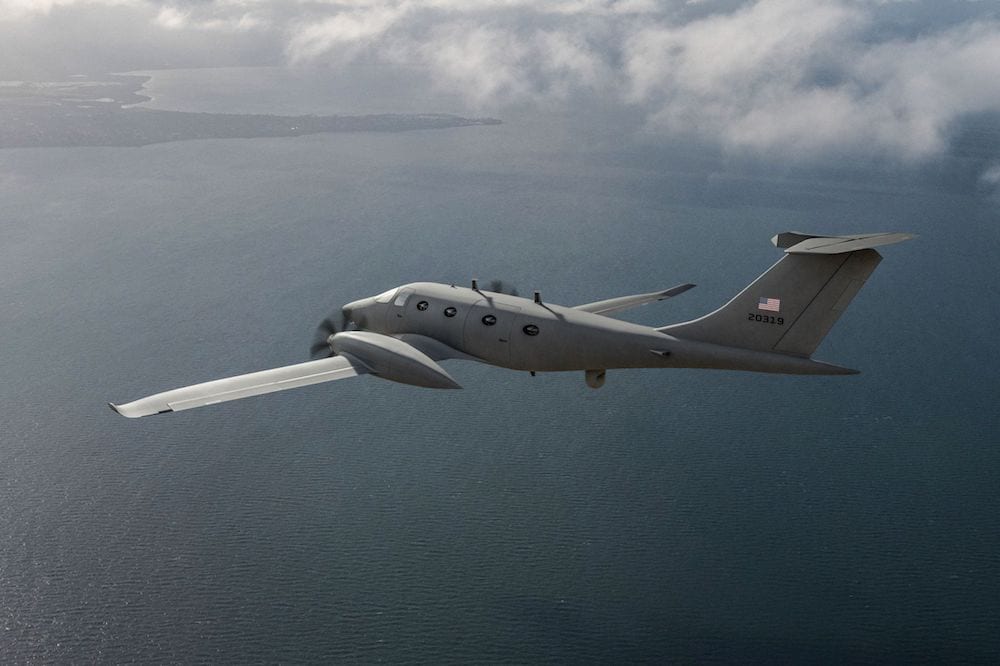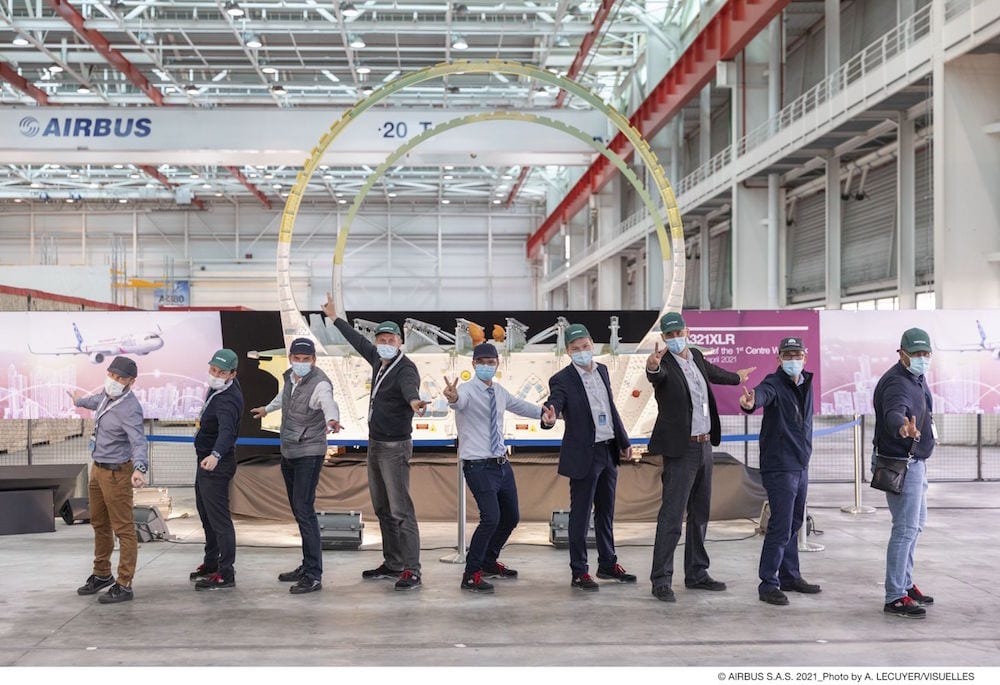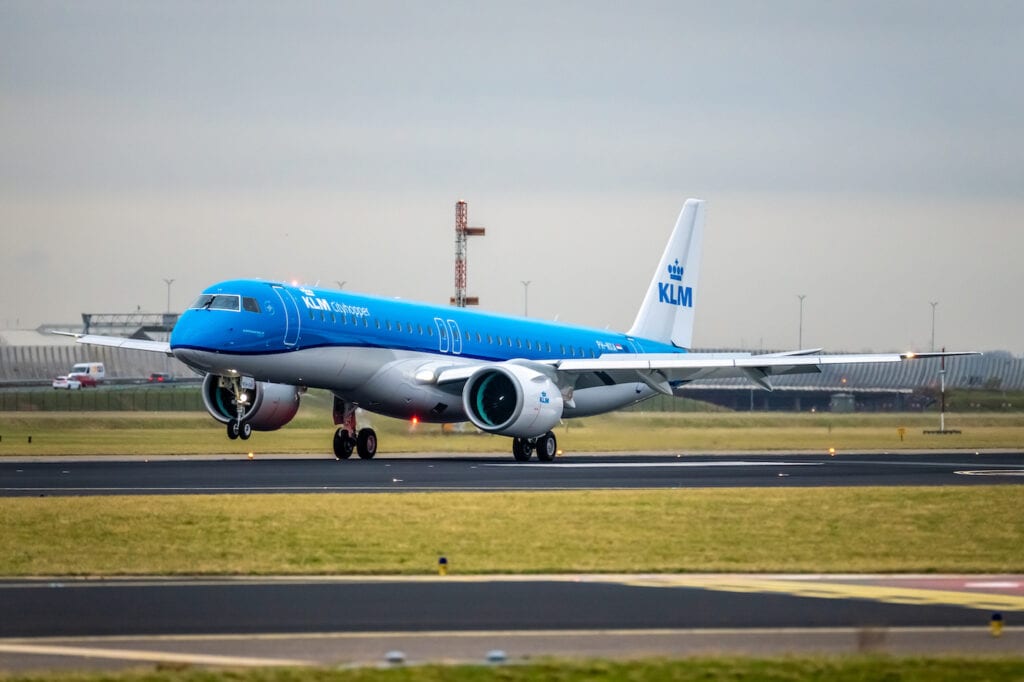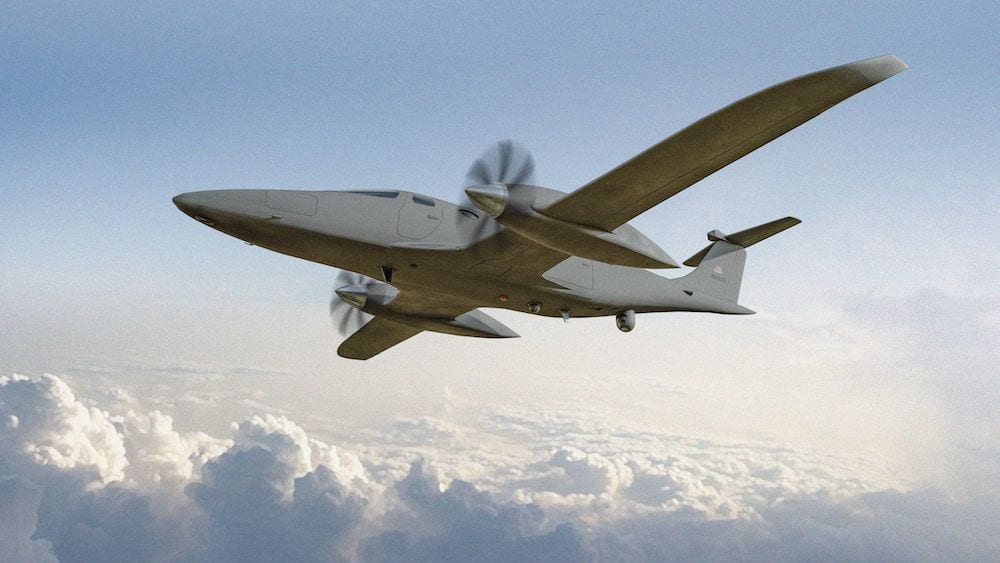What’s Trending in Aerospace – May 2, 2021

Check out the May 2 edition of What’s Trending in Aerospace, where editors and contributors for Avionics International bring you some of the latest headlines and updates happening across the global aerospace industry.
Commercial
Airbus Reports First Quarter Profit, More Deliveries

Airbus published its first quarter results last week. Airbus employees are pictured here celebrating the first A321XLR Center Wing Box delivery. (Airbus)
Airbus on April 29 reported first quarter 2021 net income of €362 million ($439 million), while completing 125 total aircraft deliveries and 39 new orders.
Revenues generated by the French aerospace manufacturer’s commercial aircraft activities decreased by 4 percent, mainly reflecting lower volume in services, according to an April 29 press release. Airbus Helicopters delivered 39 units with revenues reflecting lower volume in civil helicopters, partly offset by growth in services. Revenues at Airbus Defense and Space were also stable compared to a year earlier.
“The good Q1 results mainly reflect our commercial aircraft delivery performance, cost and cash containment, progress with the restructuring plan as well as positive contributions from our helicopter and defense and space activities,” Airbus CEO Guillaume Faury said in the release. “The first quarter shows that the crisis is not yet over for our industry, and that the market remains uncertain. We are investing in innovation and in the transformation of our Company to deliver on our long-term ambitions across the portfolio.”
Calhoun Sees 2021 As “Inflection Point” For Recovery; Boeing Posts Losses, Lower Sales

Boeing CEO Dave Calhoun said Wednesday during the company’s first quarter earnings call that 2021 will be an “inflection point” for Boeing.
Boeing on Wednesday reported lower losses in its first quarter amid signs of a recovery in commercial aerospace and the company’s defense business posted strong results, largely driven by the KC-46A aerial refueling aircraft for the Air Force.
“While the global pandemic continues to challenge the overall market environment, we view 2021 as a key inflection point for our industry as vaccine distribution accelerates and we work together across government and industry to help enable a robust recovery,” Boeing President and CEO Dave Calhoun said in a statement accompanying the earnings release.
During the company’s earnings call, Calhoun said a “full recovery is still likely a few years away” and is dependent on vaccine distribution and the lifting of travel restrictions in various domestic and regional markets. Greg Smith, Boeing’s outgoing chief financial officer, said on the call that Chinese regulators’ approval of the return to service in China of the 737 MAX passenger aircraft will also impact deliveries of the aircraft, which was grounded worldwide for more than a year following two fatal crashes in 2018 and 2019.
Sales fell 10 percent to $15.2 billion from $16.9 billion on lower revenue from the Commercial Airplanes segment and lower commercial revenue in the services segment. Defense sales were higher, primarily on KC-46A tanker orders.
The Defense, Space & Security segment increased sales 19 percent to $7.2 billion and turned in an operating profit of $405 million following a loss a year ago related to charges on the KC-46A program. Boeing, in a quarterly filing with the Securities and Exchange Commission, said 23 percent of defense sales were to international customers.
FAA Issues New Airworthiness Directive to Address 737 MAX Electrical Bonding Issues
The Federal Aviation Administration (FAA) is requiring electrical bonding modifications to the flight deck panel assemblies of some newly manufactured 737 MAX aircraft, according to a new airworthiness directive (AD) published by the agency on April 30.
In the directive, the FAA has identified a total of 71 MAX aircraft with electrical bonding and grounding issues first identified by Boeing during standard production testing earlier this month. None of the identified airplanes—delivered and those awaiting delivery—have experienced any operational issues, but will be grounded until undergoing some flight deck panel assembly modifications.
“Investigation identified design changes to the flight deck support panel assemblies, which affected the dedicated bonding and grounding paths that existed prior to the changes,” the FAA writes in the AD. “The affected areas are the P6 panel assembly, including the mounting tray for the standby power control unit (SPCU), located behind the first officer, and the main instrument panel (MIP) assembly located in front of and between the captain and first officer.”
US to Ban Air Travel From India as Nation Hit with Record Number of COVID Cases
As the number of COVID-19 cases explode and a new variant spreads in India, U.S. President Joe Biden’s administration published a presidential action statement on April 30 proclaiming all forms of travel from India will be banned starting May 4.
“The World Health Organization has reported that the Republic of India has had more than 18,375,000 confirmed cases of COVID-19. The magnitude and scope of the COVID-19 pandemic in the Republic of India is surging; the Republic of India accounts for over one-third of new global cases, and the number of new cases in the Republic of India is accelerating at a rapid rate,” the White House said in the presidential action statement.
Under the new policy, noncitizens who were residing in India for any 14-day period prior to entry in the U.S. will be banned from boarding aircraft traveling to the United States.
US Airline Passenger Mask Mandate Extended to September

The U.S. Transportation Security Administration has extended its face mask requirement for commercial airline passengers traveling through airports and onboard commercial aircraft through Sept. 13, according to an April 30 press release.
TSA’s initial requirement that went into effect in February was to be lifted May 11.
“The federal mask requirement throughout the transportation system seeks to minimize the spread of COVID-19 on public transportation,” Darby LaJoye, the Senior Official Performing the Duties of the TSA Administrator said in a statement. “Right now, about half of all adults have at least one vaccination shot and masks remain an important tool in defeating this pandemic. We will continue to work closely with the Centers for Disease Control and Prevention (CDC) to evaluate the need for these directives and recognize the significant level of compliance thus far.”
Business & GA
Embraer Expresses Cautious Optimism in First Quarter Results

KLM received their first Embraer 195-E2 in February. (Embraer)
Embraer delivered 22 total aircraft during the first quarter of 2021, including nine commercial jets and 13 business jets.
Those numbers were slightly higher than the same period a year ago, when COVID and the collapse of their commercial aviation deal with Boeing presented a double impact to the Brazilian airplane manufacturer’s financial and operational performance.
“Historically, Embraer seasonally has fewer deliveries during the first quarter of the year, and with some regions of the world, particularly the United States, starting to show better vaccination rollout and improved traffic in the commercial aviation and business aviation markets, the Company is cautiously optimistic for a more evenly balanced quarterly cadence of deliveries in 2021 as compared to 2020,” Embraer said in their first quarter earnings release.
ZeroAvia Hydrogen-Powered Test Aircraft Damaged in ‘Off-Airport Landing’

ZeroAvia’s research and development aircraft for its hydrogen propulsion system made an “off-airport” landing according to the startup, the aircraft crashed just outside of Cranfield Airport. (Image: C/O @MEHarris on Twitter)
The hydrogen-powered Piper M-class six-seater turboprop being operated by ZeroAvia as a testbed for its hydrogen propulsion system was damaged during an off-airport landing on April 29, according to a May 1 press release published by the California-based startup.
According to the release, the aircraft mad an “off-airport landing” near Cranfield Airport during a routine test flight, landing on its wheels before the left main gear and wing were caught in the “uneven terrain” where it landed. The two crew members onboard were not injured, according to ZeroAvia.
“The flight conformed to the approved test route over the airport; the structural integrity of ZeroAvia systems was maintained throughout the incident sequence and there were no unintended hydrogen or electrical releases and no fire,” ZeroAvia said in the release. “After the landing, the crew were able to safeguard the battery and safely release hydrogen from the onboard tanks, following ZeroAvia safety protocol; no fluid leaks were observed at the time; and full data logs were preserved and will be used in our investigation.”
Check out the full statement from ZeroAvia about the incident here.
Military
L3Harris Teams with Bye Aerospace to Develop All-Electric ISR Aircraft

L3Harris Technologies has partnered with Bye Aerospace to develop an all-electric ISR aircraft. (L3Harris Technologies)
L3Harris Technologies has signed a new agreement with Bye Aerospace to develop an all-electric, multi-mission aircraft that will provide intelligence, surveillance and reconnaissance (ISR) capabilities, according to an April 28 press release.
The agreement comes a week after Bye Aerospace released details about its new all-electric eight seater aircraft under development for the commercial market. Under their agreement with L3Harris, the two companies will modify the eight-seater to feature “multi-mission airborne ISR solutions.”

(L3Harris Technologies)
“Applying our missionization expertise to Bye Aerospace’s all-electric platform will help drive future mission applications,” Luke Savoie, President, Aviation Services, L3Harris said in a statement. “These platforms offer sustainability and mission advantages that will benefit a new generation of tactical manned ISR mission aircraft.”
Northrop Grumman Posts Strong First Quarter, Raises Guidance
Northrop Grumman on Thursday reported a strong open to 2021, delivering higher sales and net income, buoyed in part by the divestiture in January of its information technology services business and top and bottom-line improvements in three of its four operating segments.
The strong quarter led the company to increase guidance for sales and earnings.
Net income in the first quarter soared 153 percent to $2.2 billion, $13.43 earnings per share (EPS), from $868 million ($5.15 EPS) a year ago, driven largely by a $1.1 billion ($6.86 EPS) gain on the sale of the IT services business to Veritas. Excluding the one-time benefit, adjusted net income was still up a handsome 24 percent to $1.1 billion ($6.57 EPS), beating consensus estimates by $1.09 per share.
Sales increased 6 percent to $9.2 billion from $8.6 billion a year ago. Reduced revenue related to the sale of the IT business was more than offset by three extra working days in the quarter.
At the operating level, the Space Systems, the company’s fastest growing segment, led the strong results with sales and operating earnings up 29 and 37 percent respectively on the Ground Based Strategic Deterrent, hypersonic programs, classified work, NASA’s Artemis human spaceflight program and the Next-Generation Overhead Persistent Infrared Radar satellite program, and lower overhead rates.
Mission Systems and Aeronautics Systems also delivered strong results on a wide variety of programs including airborne radar, land and maritime systems, targeting and navigation programs, electronic warfare, classified manned aircraft, and the E-2 and F-35 aircraft production programs.
Space
Ingenuity Completes Third Successful Flight on Mars with Greater Speeds and Distance

NASA’s Ingenuity Mars Helicopter can be seen hovering during its third flight on April 25, 2021, as seen by the left Navigation Camera aboard NASA’s Perseverance Mars rover.(NASA JPL)
The Mars helicopter Ingenuity completed a third successful flight on April 25 showing progress on its abilities to fly further and faster than in the two previous demonstration flights, NASA’s Jet Propulsion Laboratory (JPL) announced.
Ingenuity’s third flight occurred at 4:31 a.m. EDT or 12:33 p.m. Mars time, according to NASA. The helicopter climbed 16 feet, which was the same as the second flight, and then flew downrange for 164 feet at a top speed of 6.6 feet per second.
“Today’s flight was what we planned for, and yet it was nothing short of amazing,” Dave Lavery, the project’s program executive for Ingenuity Mars Helicopter at NASA Headquarters in Washington, said in a statement. “With this flight, we are demonstrating critical capabilities that will enable the addition of an aerial dimension to future Mars missions.”
FCC Approves SpaceX Request to Lower Starlink’s Altitude
The FCC has granted SpaceX permission to lower the altitude of future satellites in the Starlink Low-Earth Orbit (LEO) constellation. The FCC’s decision, announced Tuesday, came despite protests from Viasat, Amazon, SES, and other satellite competitors.
The license modification allows SpaceX to change the altitude for 2,814 future Starlink satellites, from the 1,100-1,300 km range to the 540-570 km range. It also modifies the final size of the Starlink constellation by one satellite from 4,409 to 4,408. SpaceX just under 1,400 satellites in orbit at this point.
Unmanned
Wingcopter Announces New 198 Electric Triple-Drop Delivery Drone

The Wingcopter 198 has a payload of 13 pounds and a range of 47 miles. (Wingcopter)
German drone developer and manufacturer Wincopter is debuting a new all-electric vertical take-off and landing (eVTOL) fixed-wing drone capable of “triple-drop” deliveries, according to an April 27 release from the company. The new drone generation will be known as Wingcopter 198.
The Wingcopter 198 has a payload of 13 pounds and a range of 47 miles, according to the release. It is based on Wingcopter’s tilt-rotor technology and does not require infrastructure for operations.
“The Wingcopter 198 is a game-changer for drone-based deliveries, ready to create logistical highways in the sky,” Tom Plümmer, CEO of Wingcopter, said in a statement. “It can be perfectly utilized as a fleet solution in delivery networks to create new opportunities, everywhere.”
Wingcopter 198’s delivery process is fully autonomous and has beyond visual line of sight capabilities. The system moves beyond the one operator to one drone ratio and is capable of expanding it to one operator to every 10 drones, according to the release. The triple-drop delivery mechanism allows for multiple destinations per flight.
The post What’s Trending in Aerospace – May 2, 2021 appeared first on Aviation Today.
Check FastApn access for commercial satcoms at Fastapn
Flytlink – Avionics, Satcom’s and IFE Consultants






